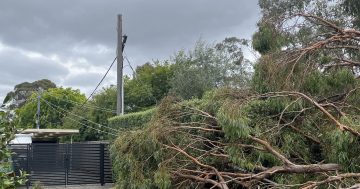
The Government has proposed a tree offset program that will require replacement trees to be planted on the same block. Photo: File.
The ACT Government has flagged a potential tree replacement scheme for the nation’s capital that will ensure that when one tree is cut down another grows in its place.
As part of its review into the Tree Protection Act 2005, the ACT Government has proposed a tree offset program that will require the property owner to either plant a replacement tree or trees on the same block.
Alternatively, the property owner could instead pay an amount into an offset fund which would be used to plant trees on public land.
The discussion paper, which was released on Wednesday, said a combination of the two approaches may be necessary to ensure offsets achieve a ‘no net loss’ result in the short to medium term.
There are an estimated 770,000 trees on private land in Canberra, and Minister for City Services Chris Steel believes nearly half of those trees could be lost in the next two decades if no framework is designed.
Mr Steel said the government wants to develop a fairer system for maintaining trees on privately leased land, as well as ensuring that the number of trees planted each year grows.
“Under our existing tree protection laws, thousands of trees are removed on leased land in Canberra and not replaced,” Mr Steel said. “We want to hear from the community how we can improve this outcome.
“We are specifically asking if the community supports introducing a system offsets so if a tree has to be removed, it will be replaced by one or more new trees.”
In the 2018-19 financial year, 1,837 applications to remove or damage trees were lodged with the Conservator of Flora and Fauna, who also provided advice on a further 420 development applications.
Mr Steel said the offset program is designed so Canberra’s tree canopy is renewed and enhanced, and to ensure property developers who remove trees when clearing land for their developments replace them.

Mr Steel said Canberrans will have the opportunity to help design a fairer system for maintaining trees on private land. Photo: File.
As part of its Climate Change Strategy and Living Infrastructure Plan, the ACT Government has set a target to increase Canberra’s tree canopy from 21 per cent to 30 per cent by 2045. While the government manages trees in public places, Mr Steel said a large part of the capital’s canopy cover comes from the trees on private land.
“In reviewing the Tree Protection Act, we want to create a framework that ensures we can enhance the urban forest through a well-designed approach to respond to the threat of climate change and underpin the health, liveability and wellbeing of Canberrans,” Mr Steel said.
“We also want to ensure trees can contribute to the health and livelihood of Canberrans for generations to come. To do this we need to look at concepts like offsets.”
Mr Steel said he also heard from the community that the system of managing trees on private land can be “inflexible” and “strict”.
“We are seeking feedback on how the legislation and strict criteria can be improved,” he said. “We want to hear from the community to look at how we increase the contribution of trees on leased land to enhancing our canopy without significantly impacting the private enjoyment of leased land.”
The ACT Conservation Council welcomed the discussion paper, with executive director Helen Oakey believing the suggestion to establish an offset scheme could be a “viable way” to help finance the development of Canberra’s urban forest.
“The Discussion Paper hints that the criteria to remove trees are too restrictive, yet in 2018-19, nearly 70 per cent of all applications made under the Tree Protection Act to remove, prune or lop protected trees were approved,” Ms Oakey said.
“It is important that large established trees are not removed with the promise that one or more smaller trees will replace it, as this won’t necessarily deliver the same habitat or canopy cover benefits.”
A copy of the discussion paper is available online or in hard copy at ACT public library branches. Public consultation closes on 8 December 2019.



















